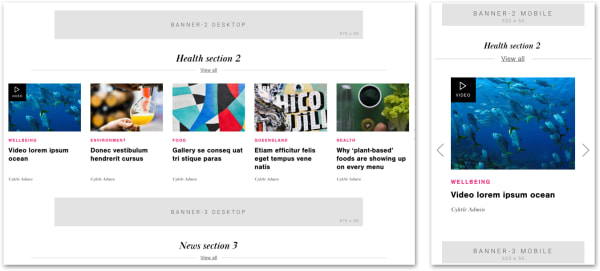Applies to: All themes. The location of each ad will depend on your theme and website layout.
It is important to note that ad metrics are not provided by the Publish platform. We strongly recommend integrating a third party service like Google Ads to gather metrics and enable your business to make informed, data-driven decisions.
Inhouse ads are an easy way to:
- Advertise features of your business or website: 'Check out our new Trade Directory' and link to a listings section, 'Sign up to our weekly email' and link to a Mailchimp form
- Gather feedback: 'Let us know what content you want to see' and link to a form
- Sell to local advertisers with a range of ad sizes and locations (see note above about ad tracking)
All Publish websites are set up with a suite of ad spots for desktop, tablet and mobile. The available sizes will include banners, MRECs and halfpage ads. The exact location and size of each ad will depend on your theme and website layout. If you're unsure of your options, contact us at support@pagemasters.com.au
The basics
- The ad location is where the ad appears on the site - eg, under the header, between two homepage panels, on an article
- Each ad location will have an ad slot for desktop, mobile and tablet
- The ad slot is the item created in the Ad Manager and is where you can add keywords, image and URL, or ad code
- Devices are referred to as desktop, tablet or mobile, and this refers to a device's typical screen size rather than the device itself. (For example, a small browser window on a laptop might be as small as a tablet screen)
How to create or edit an inhouse ad
- Go to Content > Ad Manager
- Go to the Create tab, or Edit an existing ad
- Title: Use a naming convention for ads that your team understands. You may find referring to the ad location and device useful (eg, 'banner-head desktop' – banner-head tells you the location of the ad (by the header menu), and desktop is the screen size the ad will appear on)
- Ad code: Leave this empty for inhouse ads.
- Ad URL: When a user clicks on the ad, this is the link it will open
- Ad target: Select Blank from the dropdown to open the Ad URL in a new tab.
- Keywords: Keywords must be added in this order (click Enter after typing in each one): title (eg, banner-1), device (eg, desktop), location keyword (use default if custom keywords are not being used)
- Status: Active (to turn an ad off, turn to 'Inactive')
- Upload image: Upload a 72dpi image at the correct dimensions for the ad slot. It's important that images are uploaded at 72dpi for correct screen display.
- Click Update
How to create or edit a Google Ad or other third party ad
- Go to Content > Ad Manager
- Go to the Create tab, or Edit an existing ad
- Title: Use a naming convention for ads that your team understands. You may find referring to the ad location and device useful (eg, 'banner-head desktop' – banner-head tells you the location of the ad, and desktop is the screen size it will appear on)
- Ad code: Paste in the code that your ad provider has supplied
- Keywords: Keywords must be added in this order (click Enter after typing in each one): title (eg, banner-1), device (eg, desktop), location keyword (use default if custom keywords are not being used)
- Status: Active (to turn an ad off, turn to 'Inactive')
- Leave all other fields empty.
- Click Update

–––

–––

